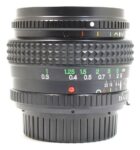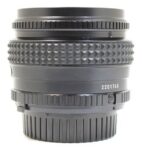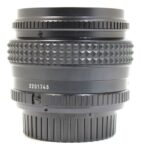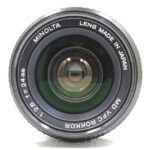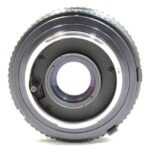Minolta MD Rokkor 24mm F/2.8 VFC
Wide-angle prime lens • Film era • Discontinued
- Announced:
- · September 1977
- Production status:
- ● Discontinued
- Country of design:
- · Japan
- Original name:
- · MINOLTA MD VFC ROKKOR 1:2.8 f=24mm
- Class:
- · Fast full-frame wide-angle prime lens
- System:
- · Minolta SR (1958)
Abbreviations
| MD | The lens is coupled to the camera's TTL exposure meter for full-aperture measurement. In addition to aperture-priority auto exposure mode, the lens also supports shutter-priority auto exposure mode. |
| VFC | The lens features Variable Field Curvature control. |
Model history (3)
| ■Minolta MC Rokkor 24mm F/2.8 VFC Gen. X | A | 9 - 7 | 0.30m | ⌀55 | 1975 ● | |
| ■Minolta MD Rokkor 24mm F/2.8 VFC | A | 9 - 7 | 0.30m | ⌀55 | 1977 ● | |
| ■Minolta MD 24mm F/2.8 VFC | A | 9 - 7 | 0.30m | ⌀55 | 1982 ● | |
Specification
| Optical design: | |
| 35mm full frame | |
| 24mm | |
| F/2.8 | |
| 9 elements in 7 groups | |
| Floating element system | |
| Minolta SR [43.5mm] | |
| 84° (35mm full frame) | |
| Diaphragm mechanism: | |
Diaphragm type: | Automatic |
Aperture control: | Aperture ring (Manual settings + Auto Exposure setting) |
| 6 (six) | |
| Focusing: | |
| 0.30m | |
| <No data> | |
Focusing modes: | Manual focus only |
Manual focus control: | Focusing ring |
| Physical characteristics: | |
| 340g | |
| ⌀67×50.5mm | |
| Accessories: | |
| Screw-type 55mm | |
| Screw-type | |
| Minolta MD 2X Tele Converter 300-S → 48mm F/5.6 |
Sources of data
- Minolta lenses: vision for the creative photographer booklet.
- Minolta Corporation Photographic Division 1981/1982 Catalog (March 1981).
- Minolta SRT cameras and systems.
- A guide to the Minolta SLR system of creative photography 803E-M1.
Manufacturer description #1
Minolta Shift and Variable Field Curvature Lenses
Special purpose lenses to control perspective or adjust field of sharp focus from flat to curved.
This remarkable wide-angle is the first lens that allows the photographer to visually determine and adjust the curvature of the lens field to conform to subject fields ranging from concave to convex. Stopping the lens down to moderate or small apertures increases depth of field to supplement the effectiveness of the VFC feature in rendering curved subjects with maximum sharpness.
At the flat field control setting the fully meter-coupled 24mm f/2.8 VFC lens offers optical performance equal to that of a conventional 24mm f/2.8 wide-angle lens.
Manufacturer description #2
This is the world's first lens whose field of sharp focus can be varied continuously at will from concave through flat to convex by simply moving a control ring on the barrel. Thus, even if distances from center and edges of objects to the film plane are too different to be covered by depth of field (particularly at close range and/or large apertures), sharp photos having excellent image quality can be obtained of many subjects by appropriately curving the field. On the other hand, this capability can also be used creatively to deliberately render parts of the subject out of focus, or the lens can be used as a conventional flat-field wideangle. Either way, optimum image quality is assured by the "floating" focusing system and Minolta Achromatic coating incorporating latest techniques.
Manufacturer description #3
Your VFC Rokkor(-X) is a sophisticated wideangle lens whose field of sharp focus can be curved to conform to various subjects. It can also be used as a conventional flat-field wide-angle lens. In either case, it gives you the advantage of the floating focusing system for sharpest edge-to-edge results at all focusing distances and apertures.
Conventional flat-field use
With the index of the VFC ring set in its click-stop at the central white diamond on the VFC scale, the field of sharp focus is a flat plane at the focused distance.
Operation, indications, and results at this setting are the same as with the conventional 24mm f/2.8 MD W Rokkor(-X) Lens.
Curved-field use
Turning the VFC control ring to the left of the central diamond changes the field from flat to concave (bowl-shaped). Turning it to the right of the diamond on the other hand, produces a convex (dome-shaped) field. These curvatures can be used to obtain sharp rendition of three-dimensional subjects (e.g., the surface of a ball, people sitting around a table, etc.) even when depth of flat field is insufficient to do so. Curving field in this way is particularly effective at relatively close focusing distances and large apertures.
Curvature extends from the focused distance at the center of the frame to a point at the corners that is either nearer or farther from the film plane than the focused distance, depending upon whether the VFC control-ring index is set respectively left or right of the flat-field setting. The curvature grows continuously deeper as the ring is turned away from the central diamond. There are three colored reference marks on left and right for convenient reference, but the index dot can be set at any point within the left and right limits.
The effect of curvature may be observed visually through the camera viewfinder or approximated from the marks behind the depth-of-field scale. For example, with the lens focused at 0.7m and the VFC control-ring dot set to the left yellow mark, the corresponding left yellow mark on the curvature-extent scale is opposite a point on the distance scale slightly to the left of "0.5." This indicates that the field of sharp focus would curve from 70cm at the center to about 48cm at the corners of the frame. This would enable rendering a subject of this approximate curvature (e.g., on alcove wall painting) all sharp even at maximum aperture. Depth of flat field, as indicated by the depth·of-field scale, would not cover this depth unless the lens were stopped down to f/5.6 with distance setting adjusted appropriately, and image quality throughout the curve would not equal that using curved field.
As a further example, turning the ring to the right red mark at the same 0.7m focus setting, on the other hand, would produce a field, as indicated by the right red scale mark on the curvature-extent scale, that curves from 70cm at the center away to 4 meters at the corners. This would allow sharply rendering both a close, centered subject and background objects at the edges a considerable distance from the camera even at full aperture.
Similar results are possible with groups, building surfaces, and other subjects that are nearer or farther away in various curves. Field deepens along the curve as the lens is stopped down.
Other wide-angle prime lenses in the Minolta SR system
Lenses with similar focal length
| ■Minolta SR mount (21) | |||||||||
| Chinon 24mm F/2.5 Multi Coated akaAuto-Alpa 24mm F/2.5 Multi-Coated | A | 10 - 9 | 0.25m | ⌀55 | ● | ||||
| Cosina 24mm F/2.8 MC Macro akaCarl Zeiss Jena II 24mm F/2.8 MC Macro akaPhoenix 24mm F/2.8 Macro | A | 7 - 7 | 0.19m | ⌀52 | ● | ||||
| Kino Precision Kiron 24mm F/2 MC | A | 8 - 8 | 0.30m | ⌀55 | 1980 ● | ||||
| Minolta MC W.Rokkor-NL 21mm F/2.8 | A | 12 - 9 | 0.25m | ⌀72 | 1971 ● | ||||
| Minolta W.Rokkor-QH 21mm F/4 • Pancake lens | M | 8 - 4 | 0.90m | ⌀55 | 1963 ● | ||||
| Minolta W.Rokkor-PI 21mm F/4.5 • Pancake lens | M | 9 - 5 | 0.90m | ⌀55 | 1962 ● | ||||
| Minolta MC W.Rokkor[-NL] 21mm F/2.8 Gen. X | A | 12 - 9 | 0.25m | ⌀72 | 1973 ● | ||||
| Panagor Auto Wide Angle 21mm F/4 | A | 9 - 7 | 0.16m | ⌀82 | ● | ||||
| Panagor Auto Wide-Angle 24mm F/2.5 PMC | A | ? - ? | 0.30m | ⌀55 | ● | ||||
| Sigma MF Super-Wide 24mm F/2.8 Multi-Coated II | A | 8 - 7 | 0.18m | ⌀52 | 1988 ● | ||||
| Sigma MF Super-Wide 24mm F/2.8 Multi-Coated | A | 7 - 7 | 0.18m | ⌀52 | 1981 ● | ||||
| Sigma[-XQ] MF 24mm F/2.8 Filtermatic Multi-Coated | A | 10 - 8 | 0.25m | ⌀62 | 1978 ● | ||||
| Sigma-Z MF 24mm F/2.8 [Multi-Coated] | A | 10 - 8 | 0.25m | ⌀62 | 1975 ● | ||||
| Soligor G/S Wide-Auto 24mm F/2.5 MC (s/n 3xxxxxx) | A | 9 - 7 | 0.30m | ⌀55 | ● | ||||
| Soligor Wide-Auto 21mm F/3.8 (s/n 1xxxxxxx) | A | 9 - 8 | 0.35m | ⌀72 | ● | ||||
| Tokina SL 24mm F/2.8 [II] | A | 7 - 7 | 0.19m | ⌀52 | ● | ||||
| Tokina 24mm F/2.8 RMC akaTokina SL 24mm F/2.8 [I] | A | 8 - 8 | 0.27m | ⌀52 | ● | ||||
| Vivitar [Auto] Wide-Angle 24mm F/2 [MC] Compact (s/n 22xxxxxx) | A | 8 - 8 | 0.30m | ⌀55 | 1978 ● | ||||
| Vivitar Wide Angle 24mm F/2.8 MC (s/n 9xxxxxxx) | A | 7 - 7 | 0.19m | ⌀52 | ● | ||||
| Vivitar Auto Wide-Angle 24mm F/2.8 (s/n 37xxxxxx) | A | 8 - 7 | 0.25m | ⌀58 | 1976 ● | ||||
| Vivitar Wide Angle 24mm F/2 MC Compact (s/n 28xxxxxx) | A | 8 - 8 | 0.30m | ⌀52 | ● | ||||
| ■Interchangeable mount (13) | |||||||||
| Sankyo Kohki W-Komura 24mm F/3.5 [Unidapter Auto] | A | 7 - ? | 0.26m | ⌀52 | ● | ||||
| Komuranon 24mm F/2.5 K·M·C | A | 11 - 8 | 0.26m | ⌀58 | 1974 ● | ||||
| Sigma[-XQ] MF [Wide] 24mm F/2.8 Filtermatic [Multi-Coated] [YS] | A | 10 - 8 | 0.20m | ⌀62 | 1972 ● | ||||
| Soligor Wide-Auto 21mm F/3.8 (s/n 1xxxxxx) [T-4] | A | 9 - 8 | 0.35m | ⌀72 | 1970 ● | ||||
| Soligor Wide-Auto 24mm F/2.8 (s/n 1xxxxxxx) [T-4] | A | 8 - 7 | 0.30m | ⌀67 | ● | ||||
| Tamron 24mm F/2.5 MC 01B [Adaptall-2] | A | 10 - 9 | 0.25m | ⌀55 | 1979 ● | ||||
| Tamron 24mm F/2.5 01BB [Adaptall-2] | A | 10 - 9 | 0.25m | ⌀55 | 1987 ● | ||||
| Tamron 24mm F/2.5 CW-24 [Adaptall] | A | 10 - 9 | 0.25m | ⌀55 | 1976 ● | ||||
| Tamron Auto 21mm F/4.5 [Adapt-A-Matic] | A | 8 - 6 | 0.25m | ⌀82 | 1970 ● | ||||
| Tamron Auto 24mm F/3.5 [Adapt-A-Matic] | A | 8 - 6 | 0.25m | ⌀72 | 1971 ● | ||||
| Vivitar Auto Wide-Angle 21mm F/3.8 (s/n 37xxxxxxx) [T-4] | A | 9 - 8 | 0.35m | ⌀72 | ● | ||||
| Vivitar Auto Wide-Angle 24mm F/2.8 (s/n 37xxxxx) [T-4] | A | 8 - 7 | 0.30m | ⌀67 | ● | ||||
| Vivitar Auto Wide-Angle 24mm F/2.8 (s/n 37xxxxxx) [TX] | A | 8 - 7 | 0.23m | ⌀58 | 1976 ● | ||||

